INTRODUCTION
Antibiotics (ABs) unequivocally play a considerable role in the control and management of infectious diseases as prophylaxis or treatment. However, the efficacy of ABs has been hampered by the propensity of antibiotic resistance (ABR) resulting in ineffective therapy. ABR is a condition that occurs when bacteria acquire resistance to ABs that were manufactured to treat the infections they cause [1]. The World Health Organization (WHO) has recognized ABR as a growing global health concern and encouraged the judicious use of ABs as a public health priority with 700,000 people dying related to ABR yearly [2] with the potential to rise to 10 million by 2050 unless actions are taken [3].
There are various factors behind the drastic increase in ABR rates including inappropriate ABs use [4,5], self-medication [6], gross consumption [5], and broad availability [7]. Mason et al. have found that ABs are widely prescribed and used in the UK (74%) [5]. Around (63.6%) of participants purchased ABs without a prescription and (71.1%) did not finish the antibiotic course once they felt better [8]. Around three-quarters (72.8%) of participants had been prescribed ABs and (27.5%) were self-medicated with ABs to treat viral respiratory infections [9]. The participants were unaware of their lack of information on the proper use of ABs, the use of leftover ABs, and ABR [10]. In Jordan, 74.2% of individuals took ABs as self-medication and misused them, thinking they were treating colds, flu, and sore throats [11].
Inappropriate prescription practices, overprescribing, doctors’ fear of potential patient complications, desire to meet patients’ expectations, diagnostic uncertainty, a lack of diagnostic facilities, public attitudes toward asking doctors to prescribe ABs for self-limiting illnesses, population’s access to ABs, insufficient patient education, the illicit selling of ABs, and the lack of efficient drug regulatory policies have all contributed to the rise in ABR [12,13]. Increasing the misuse of ABs not only leads to resistance at the individual level but also dissemination of these microorganisms to the community [14]. ABR poses enormous challenges including infection outbreaks, delayed duration of therapy, longer hospital stays, increased cost of treatment, worse patients’ outcomes, higher mortality rate, and increased economic burden [15,16].
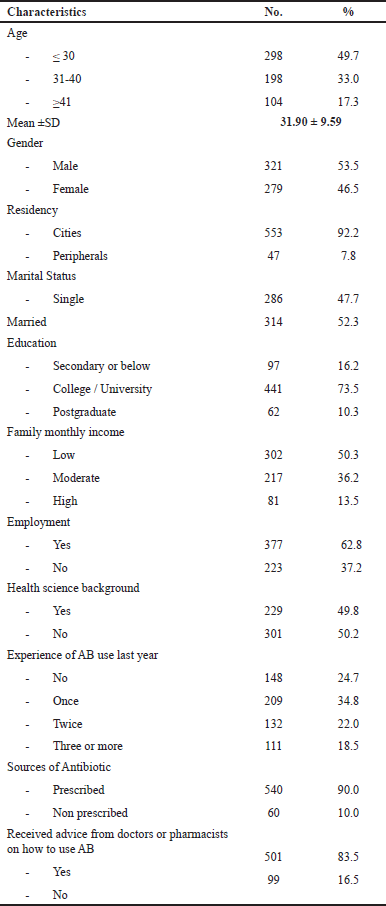 | Table 1. Socio-demographic and variables related to the use of ABs (N = 600). [Click here to view] |
Public awareness about ABs in terms of indications, proper use, safety, and resistance is suboptimal in developed and developing countries [7,17,18]. A considerable body of evidence has confirmed this claim in Saudi Arabia [19], Turkey [4], Kuwait [9], Jordan [11], Egypt [20] and Singapore [21]. Inadequate awareness is associated with unfavorable use, such as self-medication, irrational antibiotic dispensing, sharing leftover ABs with others, and non-adherence [22]. Nusair et al. reported that participants predominantly purchased ABs from pharmacies relying on pharmacists and prior experiences on how to use ABs [7]. Only 66% of participants heard about ABR in Turkey [4]. More than half of the participants were unaware that ABs are not effective against viral infections, and they discontinued them once they felt better [23]. In Egypt, 92% of the study sample was unaware of ABR, and 40.4% consumed ABs without a prescription [20]. In a study in Saudi Arabia, 75% used ABs with prescription [24]. In Jordan, self-medication with ABs was practiced by 40.4% in 2019 [7].
Therefore, it is highly recommended that regulations be put in place to ensure that ABs access is controlled only by licensed physicians, ongoing media campaigns to raise awareness of the issue, and counseling of healthcare professionals in health centers. By doing so, we can hopefully contribute to more effective strategies for enhancing antibiotic prescribing and easing global concern about ABR. Enhancing people’s health literacy and counseling has a positive impact on safe antibiotic treatment [5,25,26].
There have been a few Saudi pharmacoepidemiologic studies investigating ABR. In an attempt to fill existing knowledge gaps about ABs use and misuse, this study may be used as a benchmark for future efforts to encourage optimal antibiotic usage and raise public awareness of ABR. This study aimed to 1) assess the public knowledge, attitude and practice (KAP) toward antibiotic usage, 2) address the prevalence of antibiotic use and misuse, 3) explore the factors that contribute to inappropriate use of Abs, and 4) examine the relationship between sociodemographic characteristics and KAP toward antibiotic misuse.
METHODS
Design, sample, and setting
A cross-sectional descriptive community-based methodology was used in this investigation. A representative sample was created using an electronic snowball sampling method. The following power analysis parameters were considered to calculate the sample size: study power of 80%, confidence level of 95%, and significant level of precision of 5%. Based on these values, the required statistical restrictions can be met with a minimum total sample size of 385. To guarantee representativeness, a sample of 600 participants was gathered. The research was carried out in Saudi Arabia. College staff and students received the study link via text messages on their mobile applications and they were also instructed to forward the link to other people they know, their families and relatives, and so on. To be eligible for this study, a person had to meet three requirements: (1) be at least eighteen years old; (2) be able to read and comprehend Arabic study questions; and (3) have access to the internet and a phone.
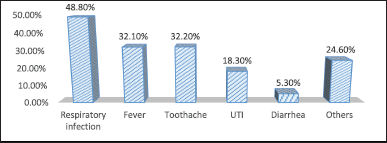 | Figure 1. Reasons for using AB (N = 600). [Click here to view] |
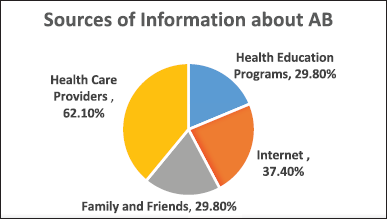 | Figure 2. Sources of information about AB (N = 600). [Click here to view] |
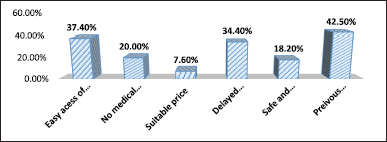 | Figure 3. Causes of AB use without prescription (N = 600). [Click here to view] |
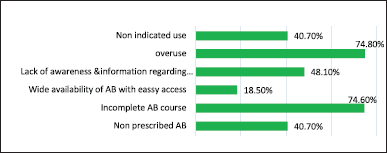 | Figure 4. Causes of AB resistance (N = 600). [Click here to view] |
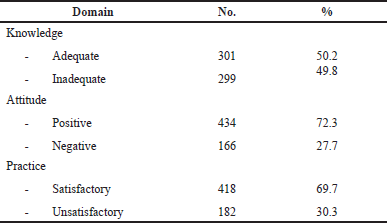 | Table 2. Total score of KAP regarding ABs use (No. = 600). [Click here to view] |
Ethical considerations
The study protocol was approved by the Institutional Review Board of Al-Ghad College for Applied Medical Sciences [Approval no. REC-NO (03/09/2023), date: 03/09/2023]. An introductory letter was written to study participants informing them of the goal of the study, their consent, and their freedom to withdraw or decline participation at any time. No vulnerable groups or sensitive issues were involved. Since no identifying or personal information was gathered, participant and data confidentiality and anonymity were preserved.
Measurement
Age, gender, education level, marital status, employment status, study or work in the health sectors, medical history, and use of ABs were among the gathered demographic information. A thorough literature review served as the foundation for the creation of the KAP questions. The second section consists of nine items with a three-point rating scale (yes, no, or I do not know), six attitudes items with a two-point rating scale (agree or disagree), and eight items with a two-point rating system (yes or no) for practice. “I do not know” response was categorized as incorrect.
The proportion of questions with correct answers was used as a scoring system and defined the cutoff point. The sum of the correct answers on the items for each participant was totaled. Participants were categorized into “inadequate knowledge” which had a score of 0–4 accurate answers and “adequate knowledge which had 5–9 correct answers. Participants were classified into “negative attitude” which had a score of 0–3 and “positive attitude” which had a score of 4–6. Participants were grouped into “unsatisfactory practice,” which had a score of 0–4 and “satisfactory practice” which had a score of 5–8.
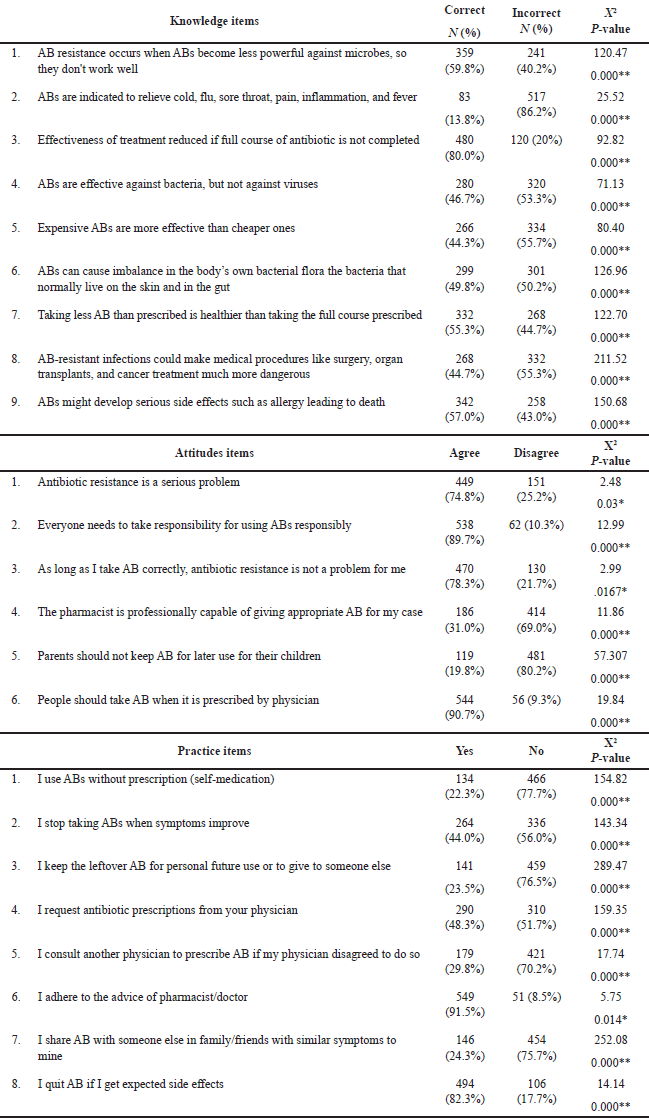 | Table 3. Percentage distribution of participants’ KAP scores regarding ABs use (N = 600). [Click here to view] |
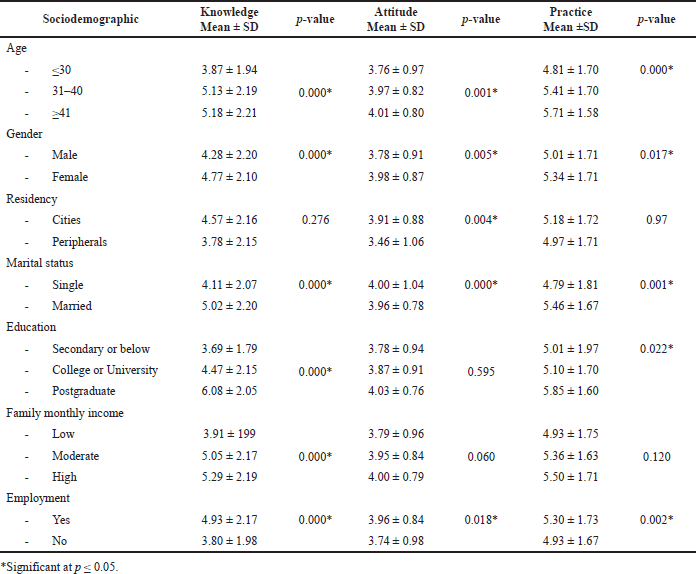 | Table 4. Association between sociodemographics and participants’ mean KAP scores (N = 600). [Click here to view] |
Experts translated the questionnaire into Arabic and then translated it back to ensure that it matched the participants’ original tongue. The instrument was pilot studied with randomly chosen participants to evaluate the validity and reliability and there were no changes made to the Arabic version. The instrument reliability was measured using Cronbach’s alpha value (0.751). The instrument face and content validity were evaluated by expert panels in the field. The instrument showed solid psychometric properties.
Data collection procedures
After receiving a brief explanation of the study, participants were asked to fill out a self-administered questionnaire. To reach a larger number of people, the data was gathered using an online survey. Participants were requested to complete the online questionnaires that had an introductory letter with a consent form. In general, it took ten to fifteen minutes to complete the questionnaires. Data for the study was gathered in September and November of 2023.
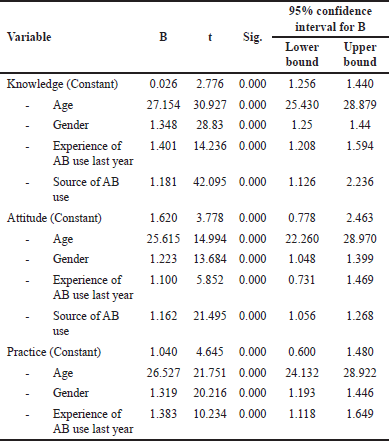 | Table 5. Multiple linear regression analysis for predicting scores of KAP regarding ABs use (N = 600). [Click here to view] |
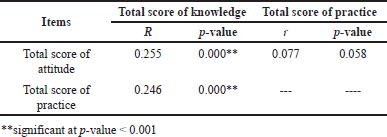 | Table 6. Correlation between Total KAP scores with AB use (N = 600). [Click here to view] |
Statistical analysis
First, the data were examined and inspected for missing information. Version 25 IBM Statistical Package for the Social Sciences statistics was used for data analysis. All the demographic variables were described and summarized using descriptive statistics in the form of means, standard deviations, frequencies, and percentages. To calculate the participants’ KAP and to compare their KAP with their demographics, various differential statistical tests were employed including chi square test, correlation, and linear regression. A significance level of p < 0.05 was applied to all statistical tests.
RESULTS
The descriptive statistics of participants’ demographic variables are depicted in Table 1. The mean age was 31.90 ± 9.59 years. Approximately half of the participants were male, married, had a health sciences background, and had income below 2,000 $. The majority of participants (92.2%) resided in cities. Around three-quarters (73.5%) had obtained a university/college degree. In addition, 62.8% of the participants were employed. Three-quarters (74.3%) reported they used ABs at least once in the last year. In terms of the sources of ABs, most participants, 90.0%, reported obtaining ABs through a prescription. A significant portion of the participants, 83.5% reported receiving advice from doctors or pharmacists on how to use ABs.
Figure 1 displays reasons for AB usage. The findings suggest that respiratory infections are a prominent driver of antibiotic usage (48.80%). Healthcare providers emerged as the most prevalent source of information, accounting for 62.1% of the responses. Although, the internet was reported as a source of information by 37.4% of the studied sample (Fig. 2). Figure 3 illustrates that the highest reported cause of using AB without a prescription was a previous prescription and leftover at 42.50%. Figure 4 reveals that the highest reported cause of AB resistance was overuse at 74.80%.
Table 2 provides a snapshot of the participants’ KAP regarding ABs use. It is worth noting that nearly half 50.2% of the sample displayed adequate knowledge, 72.3% had a positive attitude, and 69.7% had a satisfactory level of practice.
Table 3 shows a considerable proportion of respondents (86.2%) incorrectly believe that ABs are effective for relieving symptoms of cold, flu, sore throat, pain, inflammation, and fever. Similarly, a significant number of participants (53.3%) harbor misconceptions about the effectiveness of ABs against viruses, the importance of completing a full course of ABs, and the potential risks associated with ABR. The chi-square test revealed a strong association between knowledge items and the correct/incorrect responses (X2, p < 0.001).
The data demonstrates that a substantial majority of respondents, (74.8%) recognized ABR as a serious problem and believe that everyone should take responsibility for using ABs responsibly. In addition, 91.5% of the participants trusted the pharmacists in providing appropriate ABs. About 80.2% of participants disagree that parents should keep ABs for later use for their children and that ABs should only be taken when prescribed by a physician. Furthermore, the statistical analysis reveals significant findings regarding attitudes related to antibiotic use. The chi-square test results showed associations between the statements and the responses provided by the participants (X2, p < 0.001).
This table also highlights several concerning patterns in antibiotic use. About 77.7% of respondents did not engage in self-medication or use ABs without a prescription. On a positive note, many participants (91.5%) reported adherence to the pharmacists’ and doctors’ advice. In addition, the statistical analysis reveals significant findings regarding practices related to antibiotic use. The chi-square test results indicated associations between the practice items and the responses provided by the participants (X2, p < 0.001).
Older participants, male, married, higher education, and employed participants tend to have higher mean scores in KAP compared to younger, female, single, less educated, and unemployed participants, respectively. There are significant associations between age, gender, marital status, education, and employment with KAP (p =< 0.05). Experience of AB use last year, and source of AB have a significant positive association with KAP, respectively. There are no significant associations between residency and income with knowledge and practice, but there is a significant association with attitude. The results of correlations and regression are depicted in Tables 4 and 5.
Table 6 shows the correlation coefficient between the total score of knowledge and the total score of attitudes is 0.255, between the total score of attitudes and total score of practice; r = 0.077, and the correlation coefficient between the total score of knowledge and the total score of practice is 0.246.
DISCUSSION
This study emphasizes the concern about the inappropriate use of ABs and the resulting resistance through assessing the public’s KAP. The survey revealed a high frequency of ABs consumption, with three-quarters of respondents confirming usage within the last 12 months. The rate of ABs consumption in Saudi Arabia is higher than that reported by WHO in 2015 (67.5%) [27] and in Cyprus (47.9%) as noted by [4]. Meanwhile, a recent study in Indonesia showed that a similar rate (76%) had used ABs in the last six months [28]. Most participants (90.0%) reported obtaining ABs through prescriptions, emphasizing the pivotal role of proper medical guidance in ABs usage. This finding contradicts a study by El Zowalaty et al. [8], which reported that many sought ABs without a prescription, with leftover medicines as a common source.
The study highlighted the rampant misuse of ABs, particularly self-prescription, using previous leftover medications, and the role that overuse and incomplete courses have in ABR, in line with the findings of Khan et al. [10]. More awareness is needed to control this practice. According to the data, healthcare providers emerged as the most prevalent source of information, followed by the Internet. This illustrates the influence that social media and other online platforms have on the spread of health-related information about ABR [29]. A study in Makkah, Saudi Arabia, has documented similar results as the physicians were a source of information about ABs use [30]. Regarding the advice received on antibiotic use, 83.5% of participants reported they received advice from doctors or pharmacists, which was consistent with the previous research [31]. Findings revealed respiratory infections are the main reason for antibiotic usage, despite their predominantly viral and self-limiting nature, underscoring the need to increase public awareness. Emergency physicians should be alerted to unnecessary AB prescriptions.
The study identified suboptimal public knowledge of ABs echoing similar findings in South Korea [18], lower scores in Saudi Arabia [19], and higher scores in Jordan [11]. Targeted health education to promote responsible antibiotic use is urgently needed to address these issues. These discrepancies may be explained by the influence of improved health literacy, ABR awareness campaigns, and health education messages that may contribute to improving public knowledge about ABR.
In addition, the study found that approximately 60% of participants had a good understanding of ABR which is consistent with a similar study conducted in Saudi Arabia [24]. The respondents demonstrated adequate knowledge about certain aspects, such as recognizing that incomplete antibiotic administration reduces treatment efficacy. However, a significant lack of understanding was observed regarding various antibiotic-related concepts. For instance, 86.2% incorrectly believed ABs could alleviate symptoms of cold, flu, sore throat, pain, inflammation, and fever. Only 13.8% correctly identified ABs as effective solely against bacteria, not viruses, showing a decline from previous studies [24,31]. Also, misconceptions persisted about ABs’ efficacy against viruses, the importance of completing full courses, and the risks associated with ABR.
According to the data, a sizable majority of participants think that ABR is a significant problem. This result was consistent with earlier research [18]. Most participants think that everyone is responsible for using ABs responsibly, which was supported by additional evidence [32]. Interesting findings revealed that participants understood parents should not save ABs for their children to utilize later. Chang et al. reported that approximately 48.2% of respondents conveyed using ABs for children without a medical prescription [33]. Hoa et al. (2012) indicated that 63% of children in rural areas treated respiratory infections with ABs that were not needed [34]. This is a fascinating discovery because children’s unnecessary use of ABs has been connected to parental misconceptions [35].
According to the study findings, only 31% of respondents believed pharmacists were qualified to provide them with the appropriate ABs for their conditions. The knowledge that only licensed physicians should prescribe ABs is a positive awareness. Evidence has indicated that educated pharmacists dispense fewer ABs for suspected viral infections including upper respiratory tract infections [36]. The survey results supported this optimistic outlook, which revealed that more than 90% of participants believed ABs should be taken as prescribed by a physician. These findings corroborated those of an earlier local investigation that showed that the Saudi public was in favor of access-controlled ABs by certified physicians only [8]. However, the survey participants hold the negative belief that ABR is not an issue for them if they take ABs as prescribed.
Most participants in this study exhibited positive behaviors as various trends in antibiotic use were examined. Notably, the responsible behavior of refraining from self-medication and unapproved use of ABs was consistent with results from an earlier local study [24]. Encouragingly, participants demonstrated adherence to healthcare professionals’ advice, as indicated by a study by Ilktac et al. [4], emphasizing proper antibiotic use following pharmacists’ instructions. Moreover, participants showcased favorable practices, such as not storing or sharing leftover ABs, reflecting improved adherence after implementing the ABs Prescription Act in 2018 that prohibits dispensing ABs without prescription. We can conclude that there has been a significant improvement in lowering the prevalence of nonprescribed ABs [37] and lowering the leftover ABs at home for future needs [38].
The participants’ false belief that they could stop taking ABs before finishing the entire course, backed by Khan et al. [10], was a concerning finding though. These procedures lead to underdosing and poor compliance, which exacerbate ABR. Previous studies [39,40] have noted that self-medication, which is frequently motivated by financial constraints, poses risks to public safety by encouraging ABR. One noteworthy finding was that most participants reported they stopped taking ABs when they started to experience the anticipated side effects. This highlights the significance of educating patients and their families about potential side effects and the fact that stopping ABs too soon is one of the leading causes of ABR. In line with earlier studies, the study also finds a positive correlation between knowledge, favorable attitudes toward ABs, and satisfactory practices [21,24].
Consistent with previous survey results [11,18,31], the current study’s results indicate that participants who are older, male, educated, married, and employed generally have significantly higher mean scores in KAP. This study shows how education can provide people with a basic understanding of ABR and expose them to a greater variety of health-related information regarding antibiotic-related behaviors [11].
CONCLUSION
Challenges contributing to ABR include a lack of awareness, over-the-counter antibiotic purchases, easy access, and leftover usage. Educational campaigns have proven effective in improving public awareness and proper antibiotic use. The study emphasizes the need for multifaceted efforts to optimize antibiotic use, involving prescribers, pharmacists, patients, and healthcare organizations. The findings underscore the importance of stringent regulations, such as those implemented by the Saudi Ministry of Health in 2018, to improve population KAP regarding ABs. Continuous educational campaigns are recommended to address gaps in public knowledge and further promote responsible antibiotic use, ultimately combating ABR and enhancing public health.
STRENGTHS AND LIMITATIONS
This study fills the knowledge gap regarding public awareness toward ABs use and misuse. Our research offers a database of information and identifies the need for devising and implementing strategies to prevent ABs resistance. The limitations of this study include limited generalizability due to convenience sampling and online surveys. The use of close-ended questions limits the elaboration of actual KAP. The study was over-representative of young respondents, as they are the largest internet users who do not represent the target population perfectly.
AUTHOR CONTRIBUTIONS
All authors made substantial contributions to conception and design, acquisition of data, or analysis and interpretation of data; took part in drafting the article or revising it critically for important intellectual content; agreed to submit to the current journal; gave final approval of the version to be published; and agree to be accountable for all aspects of the work. All the authors are eligible to be an author as per the International Committee of Medical Journal Editors (ICMJE) requirements/guidelines.
FINANCIAL SUPPORT
There is no funding to report.
CONFLICTS OF INTEREST
The authors report no financial or any other conflicts of interest in this work.
ETHICAL APPROVALS
The study protocol was approved by the Institutional Review Board of Al-Ghad College for Applied Medical Sciences, Saudi Arabia [Approval no. REC-NO (03/09/2023), date: 03/09/2023].
DATA AVAILABILITY
All data generated and analyzed are included in this research article.
USE OF ARTIFICIAL INTELLIGENCE (AI)-ASSISTED TECHNOLOGY
The authors declares that they have not used artificial intelligence (AI)-tools for writing and editing of the manuscript, and no images were manipulated using AI.
PUBLISHER’S NOTE
All claims expressed in this article are solely those of the authors and do not necessarily represent those of the publisher, the editors and the reviewers. This journal remains neutral with regard to jurisdictional claims in published institutional affiliation.
REFERENCES
1. Bashabsh R, AL-Fawares O, Natsheh I, Bdeir R, Al-Khreshieh, Bashabsh H. Staphylococcus aureus epidemiology pathophysiology clinical manifestations and application of nano therapeutics as a promising approach to combat methicillin resistant Staphylococcus aureus. Pathog Glob Health. 2023;118(1):01–023. CrossRef
2. World Health Organization. New report calls for urgent action to avert antimicrobial resistance crisis. Volume 4.
3. de Kraker ME, Stewardson AJ, Harbarth S. Will 10 million people die a year due to antimicrobial resistance by 2050? PLoS Med. 2016;13(11):e1002184. CrossRef
4. Ilktac M, Tarabishi MT, Ozbirtan P, Gulcan C, Celik G. A public awareness study about antibiotic consumption habits and antibacterial resistance in north-eastern region of Cyprus. J Infect Dev Ctries. 2020;14(05):463–70. CrossRef
5. Mason T, Trochez C, Thomas R, Babar M, Hesso I, Kayyali R. Knowledge and awareness of the general public and perception of pharmacists about antibiotic resistance. BMC Public Health. 2018;18(1):01–010. CrossRef
6. El-Hawy RM, Ashmawy MI, Kamal MM, Khamis HA, El-Hamed NM, Eladely GI, et al. Studying the knowledge, attitude and practice of antibiotic misuse among Alexandria population. Eur J Hosp Pharm. 2017;24(6):349–54. CrossRef
7. Nusair MB, Al-azzam S, Alhamad H, Momani MY. The prevalence and patterns of self-medication with antibiotics in Jordan: a community-based study. Int J Clin Pract. 2021;75(1):e13665. CrossRef
8. El Zowalaty ME, Belkina T, Bahashwan SA, El Zowalaty AE, Tebbens JD, Abdel-Salam HA, et al. Knowledge, awareness, and attitudes toward antibiotic use and antimicrobial resistance among Saudi population. Int J Clin Pharm. 2016;38:1261–8. CrossRef
9. Awad AI, Aboud EA. Knowledge, attitude and practice towards antibiotic use among the public in Kuwait. PloS One. 2015;10(2):e0117910. CrossRef
10. Khan FU, Mallhi TH, Khan Q, Khan FU, Hayat K, Khsan YH, et al. Assessment of antibiotic storage practices, knowledge, and awareness related to antibiotic uses and antibiotic resistance among household members in post-conflict areas of Pakistan: bi-central study. Front Med. 2022;9:962657. CrossRef
11. Muflih SM, Al-Azzam S, Karasneh RA, Conway BR, Aldeyab MA. Public health literacy, knowledge, and awareness regarding antibiotic use and antimicrobial resistance during the COVID-19 pandemic: a cross-sectional study. Antibiotics 2021;10(9):1107. CrossRef
12. Ayukekbong JA, Ntemgwa M, Atabe AN. The threat of antimicrobial resistance in developing countries causes and control strategies. Antimicrob Resist Infect Control. 2017;6(1):1–8. CrossRef
13. Pereko DD, Lubbe MS, Essack SY. Public knowledge, attitudes and behaviour towards antibiotic usage in Windhoek, Namibia. South Afr J Infect Dis. 2015;30(4):134–7. CrossRef
14. Bell BG, Schellevis F, Stobberingh E, Goossens H, Pringle M. A systematic review and meta-analysis of the effects of antibiotic consumption on antibiotic resistance. BMC Infect Dis. 2014;14(1):1–25. CrossRef
15. Bonine NG, Berger A, Altincatal A, Wang R, Bhagnani T, Gillard P, et al. Impact of delayed appropriate antibiotic therapy on patient outcomes by antibiotic resistance status from serious gram-negative bacterial infections. Am J Med Sci. 2019;357(2):103–10. CrossRef
16. Naylor NR, Atun R, Zhu N, Kulasabanathan K, Silva S, Chatterjee A, et al. Estimating the burden of antimicrobial resistance: a systematic literature review. Antimicrob Resist Infect Control. 2018;7:58. CrossRef
17. Alhomoud F, Aljamea Z, Almahasnah R, Alkhalifah K, Basalelah L, Alhomoud FK. Self-medication and self-prescription with antibiotics in the Middle East—do they really happen? A systematic review of the prevalence, possible reasons, and outcomes. Int J Infect Dis. 2017; 57:3–12. CrossRef
18. Huh K, Chung DR, Kim SH, Cho SY, Ha YE, Kang CI, et al. Factors affecting the public awareness and behavior on antibiotic use. Eur J Clin Microbiol Infect Dis. 2018;37(8):1547–52. CrossRef
19. Alduhaimi GS, Alabdulkareem ME, Alhussin GI, Alhumaid LA, Basudan SK, Masud N, et al. Awareness of antimicrobial resistance: surveillance among visitors of a Tertiary Care Center, Riyadh, Saudi Arabia. Saudi J Health Syst Res. 2022;2(3):128–35. CrossRef
20. Mostafa A, Abdelzaher A, Rashed S, AlKhawaga SI, Afifi SK, AbdelAlim S, et al. Is health literacy associated with antibiotic use, knowledge and awareness of antimicrobial resistance among non-medical university students in Egypt? A cross-sectional study. BMJ Open. 2021;11(3):e046453. CrossRef
21. Lim JM, Duong MC, Cook AR, Hsu LY, Tam CC. Public knowledge, attitudes and practices related to antibiotic use and resistance in Singapore: a cross-sectional population survey. BMJ Open. 2021;11(9):e048157. CrossRef
22. Jamhour A, El-Kheir A, Salameh P, et al. Antibiotic knowledge and self-medication practices in a developing country: a cross-sectional study. Am J Infect Control 2017;45:384–8. CrossRef
23. Gualano MR, Gili R, Scaioli G, Bert F, Siliquini R. General population’s knowledge and attitudes about antibiotics: a systematic review and meta-analysis. Pharmacoepidemiol Drug Saf. 2015;24(1):2–10. CrossRef
24. Jali A, Hakami A, Dahas N, Mahnashi M, Siddiq A, Alsomaili H, et al. Antibiotic use and resistance knowledge: awareness among the general public in Jazan, Saudi Arabia. Cureus. 2021;13(12):e20369. CrossRef
25. Anderson A. Online health information and public knowledge, attitudes, and behaviours regarding antibiotics in the UK: multiple regression analysis of wellcome monitor and eurobarometer data. PloS One. 2018;13(10):e0204878. CrossRef
26. Salm F, Ernsting C, Kuhlmey A, Kanzler M, Gastmeier P, Gellert P. Antibiotic use, knowledge and health literacy among the general population in Berlin, Germany and its surrounding rural areas. PLoS One. 2018;13(2):e0193336. CrossRef
27. World Health Organization. Antibiotic resistance: multi-country public awareness survey. 2015.
28. Kristina SA, Wati MR, Prasetyo SD, Fortwengel G. Public knowledge and awareness towards antibiotics use in Yogyakarta: a cross sectional survey. Pharm Sci Asia. 2020;47(2):173–80. CrossRef
29. Aldeyab M, López-Lozano JM, Gould IM. Global antibiotics use and resistance. Global Pharm Policy. 2020:331–44. CrossRef
30. Saleh Faidah H, Haseeb A, Yousuf Lamfon M, Mohammad Almatrafi M, Abdullah Almasoudi I, Cheema E, et al. Parents’ self-directed practices towards the use of antibiotics for upper respiratory tract infections in Makkah, Saudi Arabia. BMC Pediatr. 2019;19(1):1–9. CrossRef
31. Michaelidou M, Karageorgos SA, Tsioutis C. Antibiotic use and antibiotic resistance: public awareness survey in the Republic of Cyprus. Antibiotics 2020;9(11):759. CrossRef
32. Zailani NA, Bakar NF, Zulfakar SS. Awareness of antibiotic usage and antibiotic resistance: a case study in Selangor, Malaysia. Malaysian J Med Health Sci. 2022;18(3):041–049.
33. Chang J, Lv B, Zhu S, Yu J, Zhang Y, Ye D, et al. Non-prescription use of antibiotics among children in urban China: a cross-sectional survey of knowledge, attitudes, and practices. Expert Rev Anti Infect Ther. 2018;16(2):163–72. CrossRef
34. Hoa NQ, Chuc NT, Phuc HD, Larsson M, Eriksson B, Lundborg CS. Unnecessary antibiotic use for mild acute respiratory infections during 28-day follow-up of 823 children under five in rural Vietnam. Trans R Soc Trop Med Hyg. 2011;105(11):628–36. CrossRef
35. Finkelstein JA, Dutta-Linn M, Meyer R, Goldman R. Childhood infections, antibiotics, and resistance: what are parents saying now? Clin Pediatr. 2014;53(2):145–50. CrossRef
36. Mukokinya M, Opanga S, Oluka M, Godman B. Dispensing of antimicrobials in Kenya: a cross-sectional pilot study and its implications. J Res Pharm Pract. 2018;7(2):077–082. CrossRef
37. Al-Shibani N, Hamed A, Labban N, Al-Kattan R, Al-Otaibi H, Alfadda S. Knowledge, attitude and practice of antibiotic use and misuse among adults in Riyadh, Saudi Arabia. Saudi Med J. 2017;38(10):1038. CrossRef
38. Soomro S, Alshammari HO, Alabbas YA. Awareness and knowledge about antibiotic use and resistance among students of Northern Border University Saudi Arabia. J Trop Dis. 2017;5(247):2. CrossRef
39. Abera B, Kibret M, Mulu W. Knowledge, and beliefs on antimicrobial resistance among physicians and nurses in hospitals in Amhara Region, Ethiopia. BMC Pharmacol Toxicol. 2014;15(1):1–7.
40. Aziz MM, Masood I, Yousaf M, Saleem H, Ye D, Fang Y. Pattern of medication selling and self-medication practices: a study from Punjab, Pakistan. PloS One. 2018;13(3):e0194240. CrossRef